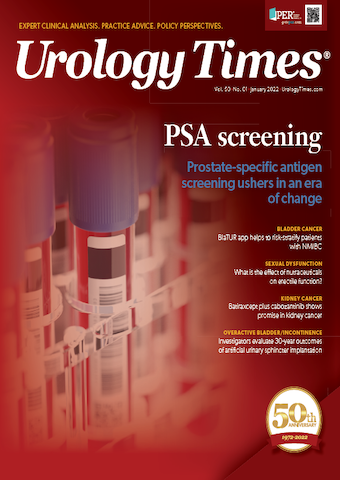Publication
Article
Urology Times Journal
Marking 5 decades of progress in cancer care
Author(s):
"As we celebrate the tremendous victories against cancer and commemorate 5 decades of progress, we are also reminded of the harsh reality that we have a war still to be won," writes Michael S. Cookson, MD, MMHC, co–editor in chief of Urology Times.
Michael S. Cookson, MD, MMHC, co–editor in chief, Urology Times

As we celebrate 50 years since the inception of Urology Times®, it is important to also commemorate the 5 decades of progress in cancer care, including prostate cancer, that have occurred in parallel. In December 1971, the National Cancer Act was signed into law.1 This legislation granted sweeping authority to the director of the National Cancer Institute (NCI) and to develop a national cancer program. Importantly, that provided funding for the NCI and other research institutes with federal and nonfederal programs, funding to establish 15 new cancer research centers and local control programs, and an international cancer research data bank.2At the time, the increased funding for the NCI amounted to nearly $700 million during the first 7 years following implementation of the law.2 Today, the NCI budget stands at $6.56 billion.
The National Cancer Act also established the first NCI-designated cancer centers, which today number 71, located across 36 states and the District of Columbia.3
Importantly, the National Clinical Trials Network allows clinicians and scientists to focus scientific efforts on the understanding, prevention, detection, and treatment of a wide variety of cancers, including those affecting patients with urologic cancers.4 Because of this network, most of our patients today have access to important clinical trials that hold the hope for improvements in cancer outcomes tomorrow. Many of the trials that have advanced the care of men with prostate cancer were developed and/or administered via these mechanisms. These include advances in androgen deprivation therapy, the development of first and now second antiandrogens, androgen synthesis inhibitors, chemotherapy, radionuclides, and immunotherapy. In addition, we have seen impressive advancements in robotic surgery, radiation therapy, genetic testing, and imaging, all of which have contributed to the improved outcomes of men with prostate cancer.
The nation’s investment in the war against cancer that was initiated by this legislation 50 years ago has been well worth it. The death rate from cancer in the US declined by 29% from 1991 to 2017, including a 2.2% drop from 2016 to 2017, the largest single-year drop ever recorded, according to an annual statistics reporting from the American Cancer Society.5 Although the largest declines were appreciated in patients with lung cancer, prostate cancer death rates in men declined 52% from 1993 to 2017, and the impact was impressive. Additionally, consider the sheer number of cancer survivors that has grown over the years. The number of people diagnosed and living with cancer has increased from 3 million in 1971 to over 16.9 million today, and the number of cancer survivors is expected to increase to 26.1 million by 2040. Approximately 67% of today’s cancer survivors were diagnosed 5 or more years ago, and about 17% of all cancer survivors were diagnosed 20 or more years ago. Nearly half (47%) of survivors are 70 years or older. Among those, 21% of these survivors are men with prostate cancer, and more than a quarter of all cancer survivors have been treated for urologic cancers.
Despite these shining examples of reductions in cancer death rates and improvements in survivors, the harsh reality remains that cancer is still the second leading cause of death in the US behind heart disease. Among our urology patients, prostate cancer remains the second leading cause of cancer deaths in men with 34,130 in 2021 alone. So as we celebrate the tremendous victories against cancer and commemorate 5 decades of progress, we are also reminded of the harsh reality that we have a war still to be won. Treatment for many patients with advanced stage cancer continues to often be ineffective, result in significant adverse effects, too expensive, and unavailable for many patients. We will look forward to the progress in cancer as we strive for a cure. And for urologists and those patient’s urologic cancers, we will harness the collective power of the modern-day NCI-sponsored cancer resources set in motion by the National Cancer Act 5 decades ago. As we move forward, Urology Times® will be there to cover progress over the next 50 years.
References
1. National Cancer Act of 1971. National Cancer Institute. Updated February 2, 2021. Accessed December 19, 2021. https://www.cancer.gov/about-nci/overview/history/national-cancer-act-1971
2. Kalberer JT Jr, Newell GR Jr. Funding impact of the National Cancer Act and beyond. Cancer Res. 1979;39(10):4274-4284.
3. The NIH Almanac: National Cancer Institute (NCI). National Institutes of Health. Updated November 27, 2019. Accessed December 19, 2021. https://www.nih.gov/about-nih/what-we-do/nih-almanac/national-cancer-institute-nci
4. NCTN: NCI’s National Clinical Trials Network. National Cancer Institute. Updated May 29, 2019. Accessed December 19, 2021. https://www.cancer.gov/research/infrastructure/clinical-trials/nctn
5. Simon S. Facts & Figures 2020 reports largest one-year drop in cancer mortality. American Cancer Society. January 8, 2020. Accessed December 19, 2021. https://www.cancer.org/latest-news/facts-and-figures-2020.html

































